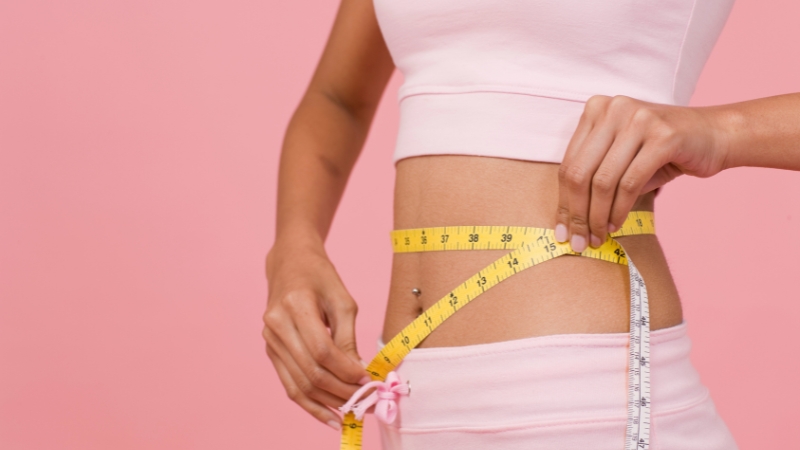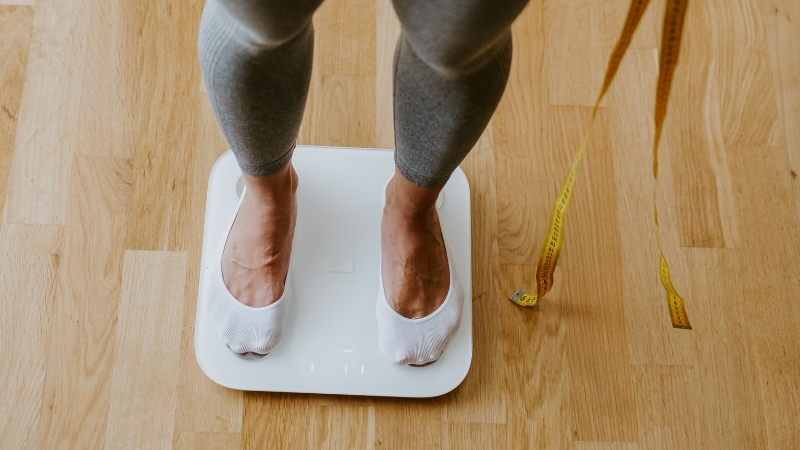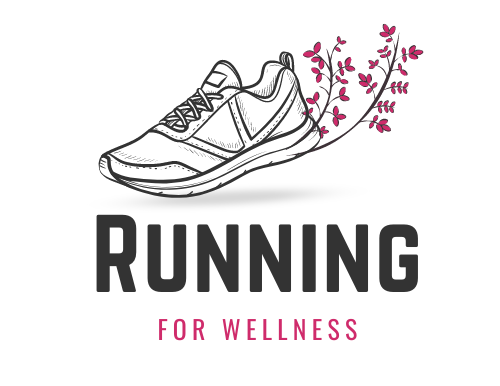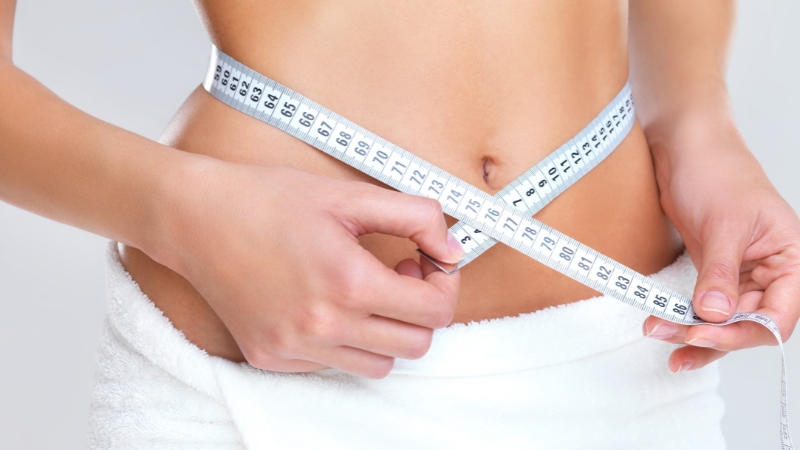The ideal weight for women in their 30s depends on several factors, but it generally falls within a healthy Body Mass Index (BMI) range of 18.5 to 24.9. For most women in this age group, that translates to approximately 50 to 75 kilograms (110 to 165 pounds), depending on height and body composition.
However, this is not a one-size-fits-all number. The healthiest weight is one that supports long-term physical well-being, stable energy levels, balanced hormones, and reduced risk of chronic disease — not just what shows up on a scale.
In your 30s, your metabolism starts to slow down slightly, muscle mass may begin to decline if strength is not maintained, and hormonal fluctuations can affect how your body stores fat.
That makes this decade a critical time to assess your lifestyle, nutrition, and activity habits, especially if you plan to maintain or improve your weight for fertility, energy, and disease prevention.
Healthy Weight Ranges for Women in Their 30s by Height
This table provides approximate ideal weight ranges for women aged 30–39, using the standard BMI range of 18.5–24.9. These are not fixed rules but useful benchmarks.
Height
Healthy Weight Range (kg)
Healthy Weight Range (lbs)
150 cm / 4’11”
46 – 56 kg
101 – 123 lbs
155 cm / 5’1″
48 – 59 kg
106 – 130 lbs
160 cm / 5’3″
50 – 63 kg
110 – 139 lbs
165 cm / 5’5″
54 – 67 kg
119 – 147 lbs
170 cm / 5’7″
57 – 71 kg
125 – 157 lbs
175 cm / 5’9″
60 – 75 kg
132 – 165 lbs
180 cm / 5’11”
63 – 79 kg
139 – 174 lbs
What Makes an “Ideal” Weight?

The term ideal often suggests a perfect number, but in medical and lifestyle terms, it simply refers to a weight that allows your body to function optimally – physically, hormonally, and mentally.
In your 30s, your weight should support the following:
Instead of obsessing over a single number, many health professionals recommend aiming for a healthy range and watching waist circumference (ideally under 88 cm or 35 inches for women) as a sign of healthy fat distribution.
Tracking Progress and Personalizing Your Target
When determining your specific healthy weight target, factors like genetics, muscle-to-fat ratio, and lifestyle must be considered. Women with naturally denser frames will have higher ideal weights, even if their BMI is normal.
On the other hand, chronically dieting to reach an unrealistic number can backfire, leading to muscle loss, poor hormonal balance, and slower metabolism.
To find a more accurate and individualized weight goal, many women use a weight loss calculator, which takes into account their height, age, current weight, target timeframe, and activity level.
These tools can estimate not just an ideal weight, but how many calories you should consume per day and how long it will realistically take to lose fat while preserving lean mass.
Using a weight loss calculator is especially helpful when planning lifestyle changes like improving nutrition, increasing movement, or reversing metabolic slowdown in your 30s. It provides a data-driven alternative to arbitrary goals — something that’s critical in an age of misinformation and crash diets.
Why Weight Becomes Harder to Manage in Your 30s
Many women experience weight gain or fluctuations during this decade due to a mix of hormonal, lifestyle, and environmental factors. Here are the main challenges and how to address them:
1. Lower Metabolic Rate
Resting metabolic rate (RMR) drops slightly after your 20s. That means you burn fewer calories at rest, even if you haven’t changed your habits.
The best solution is to preserve or build muscle mass through resistance training, which boosts RMR over time.
2. Increased Stress and Cortisol
Women in their 30s often juggle career, family, and household responsibilities, leading to elevated cortisol. Chronic stress can increase fat storage, especially around the abdomen, and interfere with sleep and insulin sensitivity.
Managing stress through exercise, sleep hygiene, and scheduling downtime is essential.
3. Less Time for Exercise
Work obligations, childcare, and reduced recovery ability can make structured workouts harder to maintain. Instead of long sessions, try short, effective workouts like 20-minute HIIT, home strength routines, or walking meetings.
Obstacle
Simple Solution
Low energy
Focus on nutrient-dense whole foods
Lack of time
15–30 minute structured home workouts
Poor sleep
Digital cutoff 1 hour before bed
Slower metabolism
Lift weights 2–3x per week
Nutrition Tips for Reaching and Maintaining a Healthy Weight
View this post on Instagram
A post shared by Anuja Mudda Shetty | Nutritionist and Fat Loss Coach (@mindfulwithanuja)
Nutrition becomes more important in your 30s than in your 20s due to hormonal shifts and a greater risk of fat accumulation from small caloric surpluses.
Focusing on balanced, sustainable meals rather than restrictive diets leads to better long-term outcomes.
Key Guidelines
Nutrient Focus
Goal Per Day
Protein
80–120g (based on weight & activity)
Fiber
25–30g
Water
2–2.5 liters
Added Sugar
< 25g
Whole Foods Ratio
80% of total intake
Exercise and Lifestyle Habits That Support a Healthy Weight in Your 30s
@laceyufit 6 habits that changed my body in my 30s: 🥩 Eat high-protein – Want to build muscle? Start by increasing your protein intake. 🚶♀️ Take daily walks – Supports digestion and helps hit your step goal. 🍫 Follow the 80/20 rule – Mostly whole foods, but never skip your favorites. 🏋️♀️ Lift weights – This is where shape and curves come from. 💤 Prioritize recovery – Because muscle doesn’t grow during workouts… it grows after. 🍽️ Listen to your hunger cues – Especially helpful when eating out or navigating social events. #B#BusyMomLifeM#MomLifeBalanceF#FitnessInYour30sS#SimpleFitnessH#HealthyHabitsF#FitMomJourneyS#StrongNotPerfectM#MomLifeHustleW#WellnessJourneyK#KeepItSimpleF#FitnessMotivationA#ActiveLifestyleM#MomGoalsS#SelfCareForMoms ♬ original sound – Laceyufit
Incorporating movement that fits your life is more sustainable than starting intense routines that lead to burnout. The goal is consistency, not intensity.
Bottom Line

The ideal weight for women in their 30s isn’t about reaching a precise number. It’s about maintaining a range that supports your energy, hormonal health, and physical function – while allowing you to live without restriction or chronic dieting.
A realistic target will depend on your height, muscle mass, lifestyle, and long-term goals.
Rather than relying on generic charts or short-term fixes, consider using a weight loss calculator to understand your targets and pace of progress.
Combined with strength training, nutritious eating, and stress management, it’s possible to not only achieve your healthiest weight — but maintain it for decades.
Related Posts:
- Half Marathon Training Plan for Beginners - Simple…
- How Long Does It Take to Train for a Half Marathon?
- How to Run with Tight Hip Flexors Without Making It Worse
- How to Protect Your Career from Injuries - Tips for…
- How Far Is a Half Marathon? Everything You Need to Know
- Top 400 Hilarious Gym Quotes to Keep You Motivated







